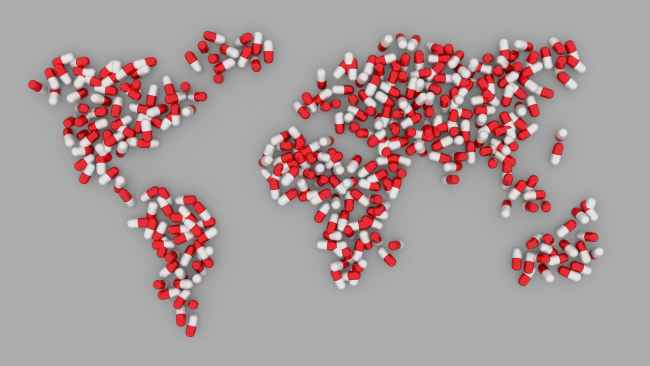You may have heard of counterfeit drugs in the context of rave culture and illegal substances. However, you may be surprised to find out that there are a number of subpar, fake drugs flying around the global pharmaceutical industry itself. That’s right — people are getting counterfeit medication and suffering the consequences of it.
On the home front, most of us are aware of the opioid crisis and the terrible ways the drugs can affect human bodies when abused. Counterfeiters have taken it upon themselves to use this crisis to their advantage, especially when patients become addicted to medication long after they need it. But the counterfeit drug problems don’t stop here.
Drugs of poor-quality have made rounds in the pharmaceutical industry in places like the Middle East. These are products passed around and sold as household medication, but they are of a lesser quality and can be very dangerous. There is action being taken by authorities and medical professionals in order to get the right medication into the hands of those who need it and stop the counterfeits from getting into the market in the first place. But before addressing the specifics, it’s good to understand a bit more about the issue itself.
Vulnerable Communities
While counterfeit medication seems to be an issue all over the world, it tends to hit hardest in developing countries. Many of the reports about fake medication come from the Middle East. Pakistan and India have notably been hit hard.
In 2017, the World Health Organization reported that 1 in 10 medical products in low or middle-income countries are substandard or counterfeit.
“There was the time when 200 people died in Pakistan after taking a contaminated heart medication in 2011,” Rae Ellen Bichell of NPR recently reported. “And there was the time when more than a thousand people were hospitalized in the Democratic Republic of Congo after taking a fake drug in 2014 and 2015. It turned out to contain an antipsychotic used to treat schizophrenia. In each case, people have profited from causing such harm, a dangerous get-rich-quick scheme.”
Some of these drugs are highly addictive as well. The balance between managing pain and avoiding addiction is already an issue when it comes to prescription medication. When dealing with counterfeit drugs, however, the very lives of those who take them may be at stake. Sadly, some pharmacists find counterfeit drugs to be convenient due to their low price. As Reuters explains, “some pharmacists in Africa … say that they are compelled to buy from the cheapest but not necessarily the safest suppliers to compete with illegal street traders.” The consequences of this can be dire.
A Legal Edge on the Issue
Across the world right now, law enforcement and government powers are working to reduce the influx of these drugs. In India, for instance, the government is using blockchain technology (the same systems that power Bitcoin and other cryptocurrencies) to track these fake substances. While it’s not a foolproof solution (since it doesn’t track black market sales), it may help to eventually move counterfeits out of established pharmacies.
It’s important to recognize that this isn’t only a product of developing countries, though. From 2013-2015 Maine legally allowed a non-FDA approved generic of Nexium in their drug market. Nexium is a proton pump inhibitor used for specific diseases like GERD, and an inferior generic could be detrimental to those who need it. Drugs like this are popular among counterfeiters, but it is uncommon for similar synthetics to be sold in American pharmacies.
Situations like this are uncommon, as most counterfeit medications are bought through online pharmacies. This makes it difficult to prosecute those responsible for selling fake drugs, as most of these online pharmacies are actually based outside of the United States. However, law enforcement is working to do a better job of screening what kinds of products come into the country. Hopefully, they can slow the entrance of fake medication.
Modern Day Medical Heroes
While law enforcement and world governments work to stop the problem by legal means, some medical professionals are working hard to combat the issue as well.
“A tech firm called Sproxil is experimenting with attaching scratch-panel stickers to packets of medicines so that workers in health clinics can scratch to reveal a code, which they then text to Sproxil,” note the experts at Ohio University. “After the company confirms the authenticity of the code, it responds with a go-ahead. This service, called Sproxil, serves customers on six continents.”
This is huge progress, certainly, but it doesn’t fix the problem of medication scarcity in poor countries. So while counterfeit drugs are making their way into the hands of patients around the world, there are thankfully good people trying to combat it. This group of heroes includes medical professionals, government officials, nonprofit workers, medication firms, and journalists who cover such crises. Hopefully with a combined effort, we can eventually stomp out the counterfeit drug problem once and for all.
Photo Credit
Photo is pixabay creative commons
Guest Author Bio
Jori Hamilton
 Jori Hamilton is a writer and journalist from the Pacific Northwest who covers social justice issues, healthcare, and politics. You can follow her work on twitter @HamiltonJori, and through her portfolio at Writer Jori Hamilton.
Jori Hamilton is a writer and journalist from the Pacific Northwest who covers social justice issues, healthcare, and politics. You can follow her work on twitter @HamiltonJori, and through her portfolio at Writer Jori Hamilton.
Recent Guest Author Articles:
- How Does Ultrasound Therapy Enhance Skin Firmness Without Surgery?
- From License to Lifestyle - How State Choice Impacts Nursing Journeys
- Your Online Reputation Is Everything (Here's How to Build It Fast)
- 5 Spiritual Resources to Help Humanity in Times of Crisis
- Between Judgment and Hope: Navigating the Gray Areas of the Justice System



Please Share Your Thoughts - Leave A Comment!